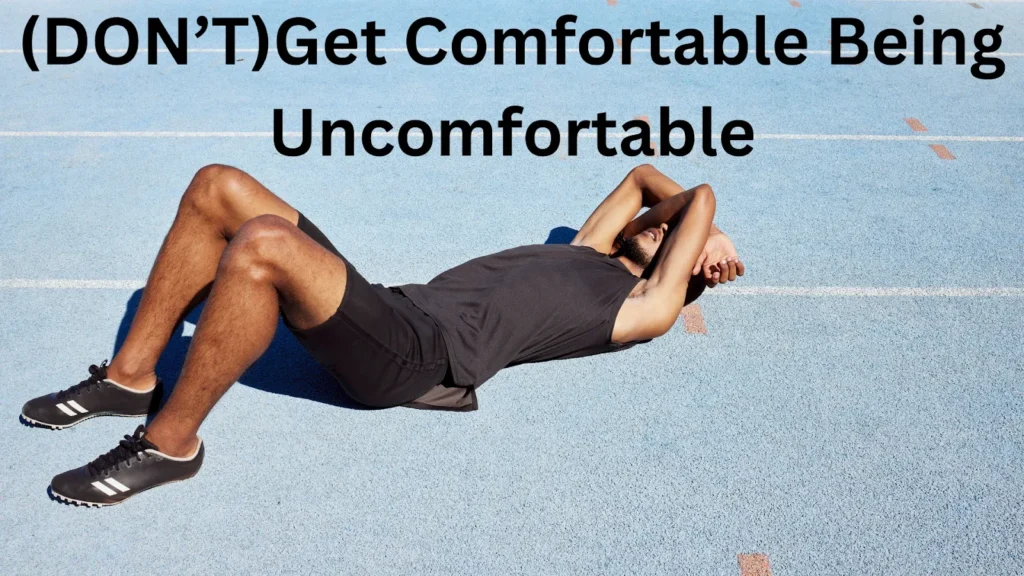(Don’t) Get Comfortable Being Uncomfortable for High Performance

I am so excited to write this article because I hate a lot of sports clichés.
This one is among the most frustrating.
I’ll start with what this phrase gets right.
Namely how embracing discomfort can promote personal and athletic development.
I’ll shed some light on the nuances that differentiate individuals on this journey, and distinguish between discomfort and fear.
I’ll give you five compelling reasons why embracing discomfort is the key to high performance, and two big reasons why it does NOT mean getting comfortable with it.
Finally, we will explore five powerful strategies to help you (not) get comfortable being uncomfortable on your path to excellence.
How Can Being Uncomfortable Help You Grow?
The journey to athletic excellence is filled with challenges, setbacks, and moments of extreme discomfort.
Maybe even pain.
Certainly sacrifice and failure.
None of which feel good.
However, it’s precisely in these moments where you grow.
Embracing discomfort is the first step towards personal and athletic development.
Here’s how it works:
Let’s use developing muscular strength as an example.
Lifting light weights comfortably will not stimulate growth.
Heavier weight with greater resistance creates more discomfort and more strength at the same time because they are related.
Imagine you are doing everything you know how to do and are doing it well.
If you stay in that bubble of comfort, where do you imagine you will be in a few years?
Likely in the same place you are today.
This is because discomfort is a natural part of change.
Trying a new skill can be awkward and uncomfortable.
Making mistakes as you learn can be embarrassing.
Being around people you don’t know, such as new teammates or coworkers in a new job, can be socially uncomfortable.
Setting a personal record means you have to do something you’ve never done before – and that will certainly be uncomfortable if it means lifting more weight than you’ve ever lifted or running/swimming faster than you ever have before.
Notice that in all these uncomfortable situations is exposure to something novel.
A new behavioral pattern, a new way of thinking, a new social challenge, a new emotional experience.
And because it is unfamiliar, it is uncomfortable.
And because it is unfamiliar you need to practice it and develop it in order to get better at it … feeling uncomfortable through it all.
It is only after familiarity with these new experiences that comfort follows.
This is why “get comfortable being uncomfortable” is such a popular phrase.
Does Everyone Get Comfortable Being Uncomfortable in the Same Way?
Yes and no.
While the concept of embracing discomfort is universal, the way each person experiences and moves through discomfort will vary.
Each person has a unique threshold for discomfort.
What might be a minor challenge for one person can be a significant hurdle for another.
This threshold is shaped by personal experiences, genetics, and mindset.
A willingness to embrace challenges and learn from failure can significantly impact one’s ability to get comfortable being uncomfortable.
Those with a growth mindset and those who demonstrate psychological flexibility tend to thrive in uncomfortable situations.
Athletes, performers, and business professionals with years of experience might find certain discomforts less bothersome given their experience.
The nature of your goals plays a role in how you perceive discomfort.
If your goal is to achieve high performance in a specific domain, you might willingly endure discomfort in that area while shying away from it in others.
Expectations matter as well. If you have the faulty belief that the task should be easy, you are likely to find discomfort difficult to endure.
This is where quitting becomes an option..
Regardless of your current level of willingness, having a mentor or coach who understands the nuances of discomfort and who can provide guidance can be a game-changer.
A sport psychologist can look at your unique psychological makeup and teach you specific skills to help you get comfortable being uncomfortable.

What Is the Difference Between Being Uncomfortable and Being Scared?
Being uncomfortable and being scared are similar in that they both can be interpreted as unpleasant experiences.
Discomfort is a broad term encompassing any situation or feeling that is outside your comfort zone.
It can range from physical discomfort during intense training to the mental discomfort of facing a tough opponent or making a high-stakes business decision.
Discomfort is often accompanied by stress and anxiety but doesn’t necessarily include a sense of impending danger.
Fear is a primal, instinctual response to a perceived threat or danger.
It triggers the “fight or flight” response and is associated with acute stress and heightened physiological arousal.
Fear is a more intense emotional state than discomfort and is typically linked to specific, imminent risks.
In short, discomfort is a milder, more manageable state of unease that arises from challenging situations, whereas fear is a potent emotional response to perceived danger.
As a high performer, you want to embrace both.
We’ve discussed the importance and benefits of getting comfortable being uncomfortable above.
Fear and anxiety is another normal and beneficial human experience in the pursuit of excellence.
Too much to go into in this article, but I have a free training video for you on how to best manage anxiety here.
5 Reasons Why Getting Comfortable Being Uncomfortable Can Help with High Performance
Now that we’ve explored the fundamentals, let’s dive into five compelling reasons why mastering discomfort is a critical skill for high performers.
Improved Stress Management:
When you embrace discomfort, you develop superior stress management skills. High-pressure situations no longer overwhelm you, and you can maintain focus and composure under duress.
Enhanced Decision-Making:
In both sports and business, critical decisions often need to be made under uncertain and uncomfortable circumstances.
Those who are comfortable with discomfort can make more rational, strategic decisions rather than succumbing to panic.
Increased Adaptability:
The ability to adapt to changing conditions is a hallmark of high performers.
Embracing discomfort fosters adaptability, allowing you to pivot and thrive in ever-changing environments.
This flexibility can be the difference between winning and losing.
Elevated Confidence:
As you conquer discomfort repeatedly, your confidence builds.
This self-assurance tends to help performers focus clearly on what’s important now, in the moments action needs to be taken.
Heightened Resilience:
Resilience, the capacity to bounce back from setbacks, is a key attribute of high achievers.
Setbacks, mistakes, disappointments, and failures are all incredibly uncomfortable.
And they may never become comfortable (see next section below).
So your ability to truly embrace the discomfort and the unpleasantness of the experience is critical to your ability to execute.
Two Big Reason You Shouldn’t Get Comfortable Being Uncomfortable
So here it is, why I hate the phrase “get comfortable being uncomfortable.” It comes down to two things.
First, if you are ever comfortable being uncomfortable, then you are no longer uncomfortable and out of that place where growth occurs.
Second, the phrase still prioritizes comfort. I want you to get out of the habit of seeking relief. It undermines the acceptance that is needed.
Acceptance isn’t comfortable.
We don’t accept things to feel better.
Our focus is on improvement.
Our priority is performance.
Do not place emotional relief or comfort in your sights. I fear “get comfortable being uncomfortable” will distract some back into that emotional agenda of seeking comfort over behavioral results.
If the goal continues to be comfort, once you have it, you will be reluctant to push yourself outside of it again.
Look, I get the spirit of it.
This phrase has guided many US Navy SEALS through ridiculous amounts of adversity.
It is a phrase that intends to change your aversive relationship with discomfort.
But the words we use matter.
Any suggestion to get comfortable risks prioritizing your feelings to the detriment of your performance.
That’s why I prefer the US Marines’ version, “Embrace the suck.”

Five Powerful Ways to Embrace the Suck
Now this phrase is much more to the point! Here are five ways to get it done:
- Know what you’re getting yourself into and truly accept the experience:
If you embrace the suck to feel better, it won’t work.
You can’t back into it that way.
Look at the task ahead of you and look directly at how unpleasant it will be and make a decision.
Will I willingly go through this for the goal on the other side?
- Seek Discomfort Deliberately:
Make a conscious effort to seek out discomfort in various aspects of your life.
Whether it’s trying a new exercise routine, taking on a public speaking opportunity, or tackling a complex problem, actively seek out opportunities to embrace discomfort.
This intentional seeking and decision to engage discomfort will strengthen your mental and emotional muscles.
- Progressive Exposure:
Gradually expose yourself to discomfort.
In sports, this might mean incrementally increasing the intensity of your training.
In business, it could involve taking on progressively more challenging projects.
Learning is best done when the challenge is just beyond your current level.
This method allows your mind and body to adapt without overwhelming you.
- Learn from Failure:
Embrace failure as a stepping stone to success.
High performers understand that failure is an integral part of growth.
Analyze your failures, extract lessons from them, and use these insights to improve your future performance.
- Find the Meaning in Your Pain:
Most of all, you need a reason to willingly go through the discomfort. If you have no purpose tied into your experience, relief will always win. Define your why and keep it close.
Conclusion
As you set out to achieve your goals, remember that discomfort is not your enemy; it’s your greatest teacher.
Embrace it, learn from it, and watch how it contributes to your success. It’s also not something you need to do alone.
Enjoy the support of Success Stories as you overcome your obstacles.



